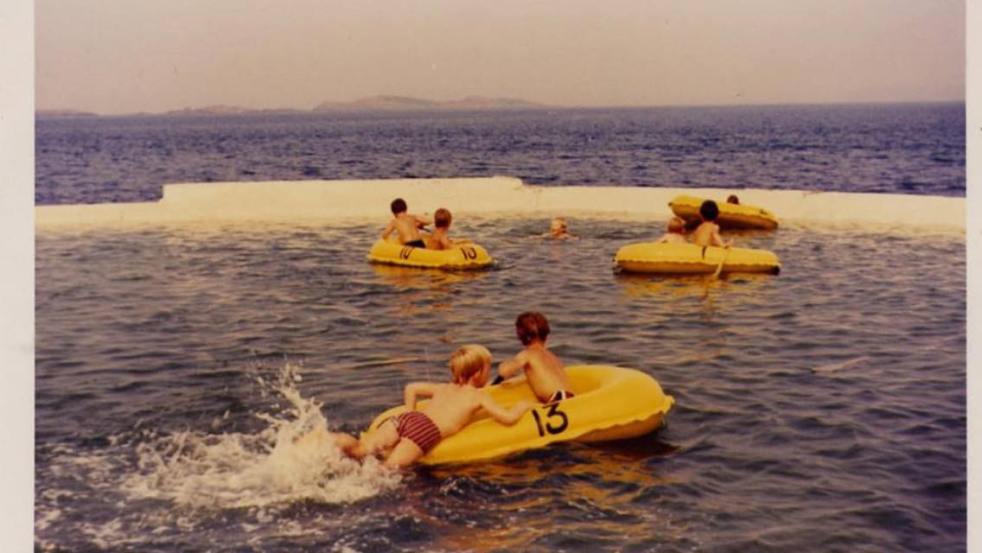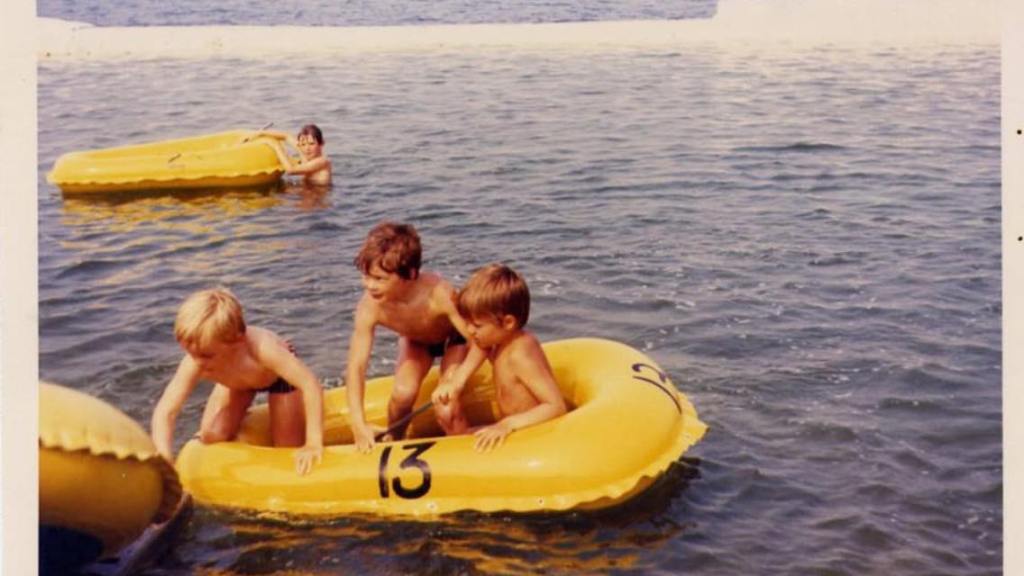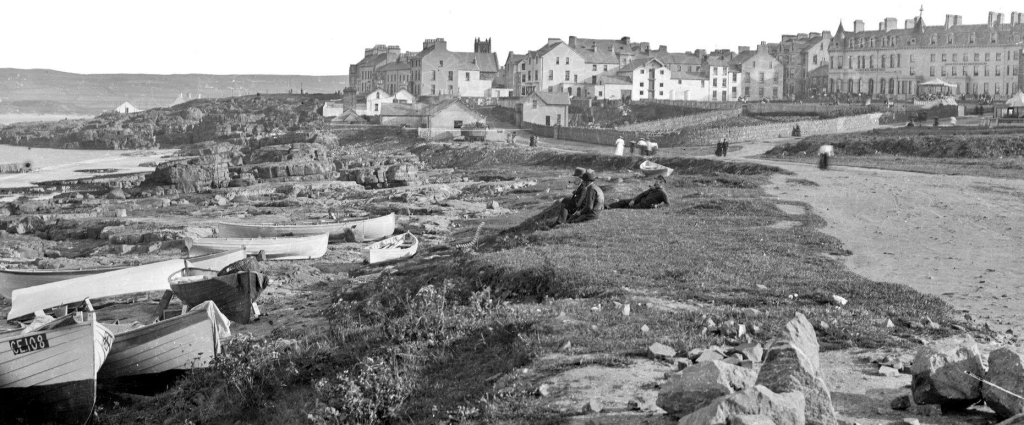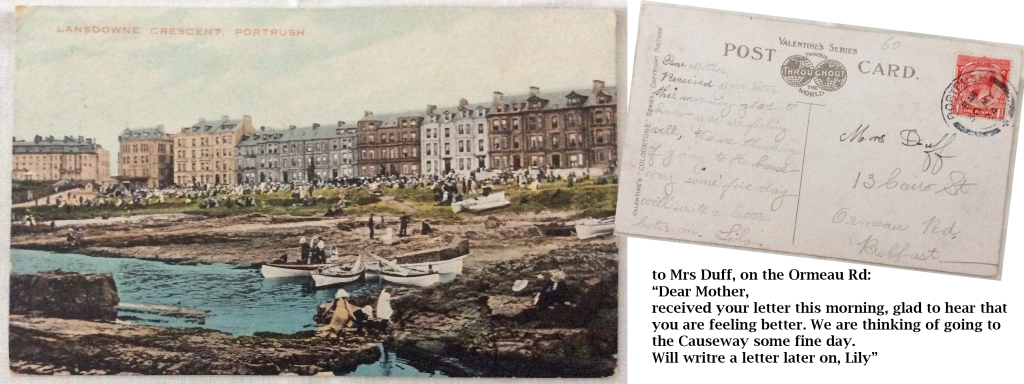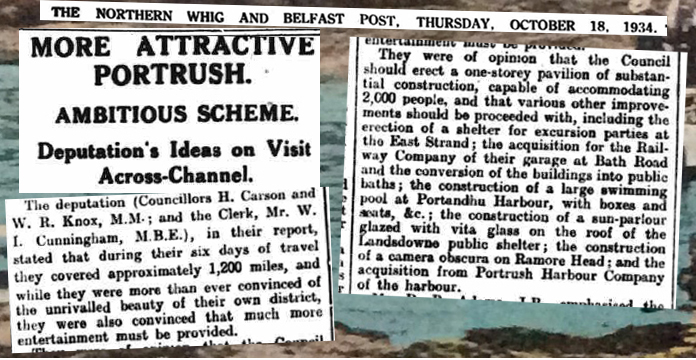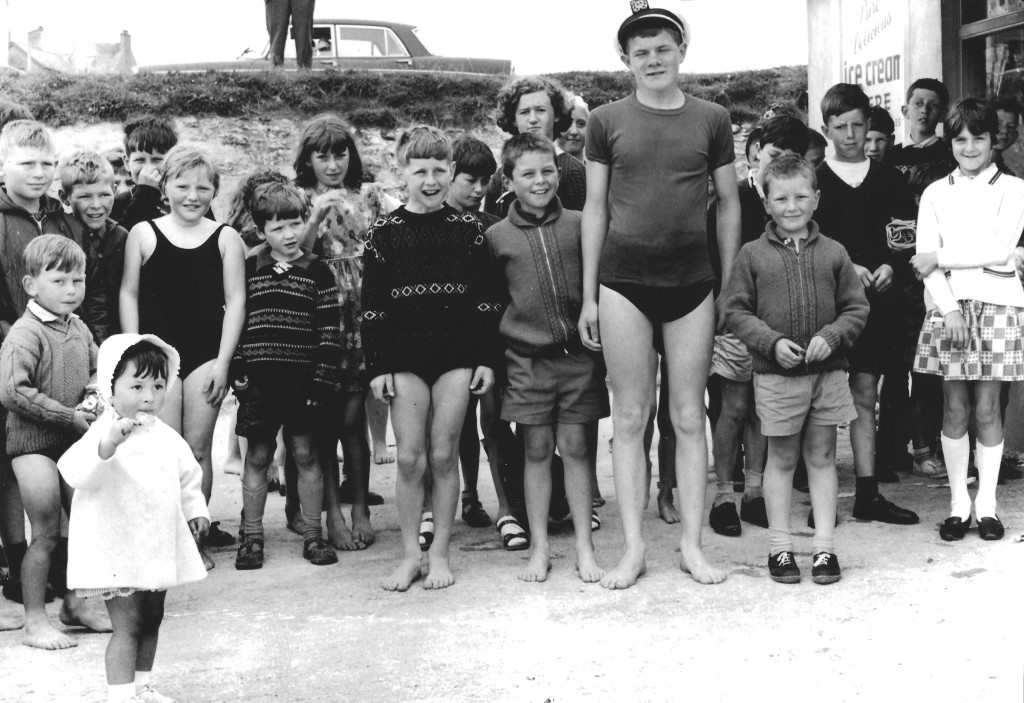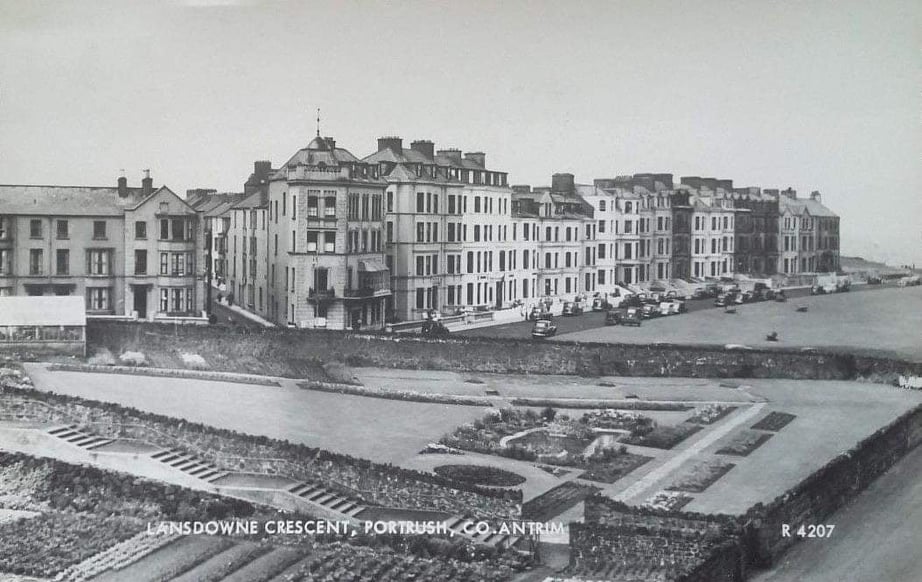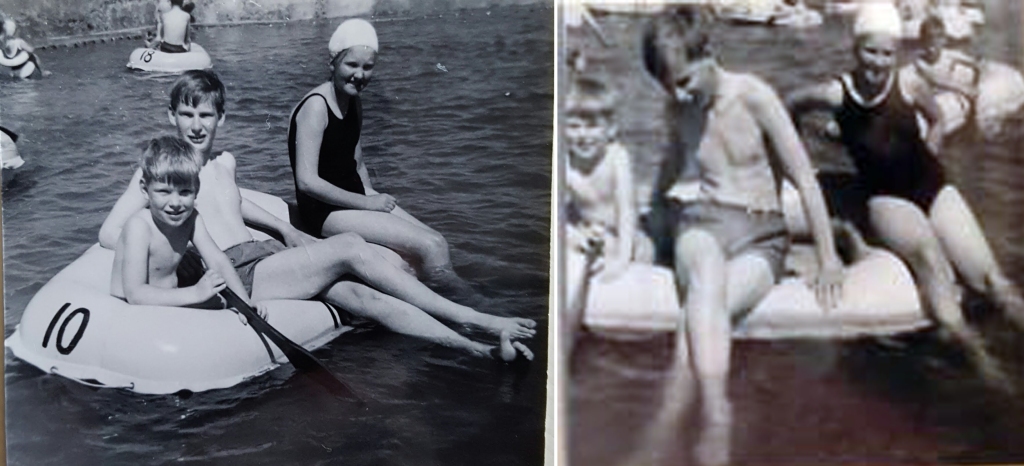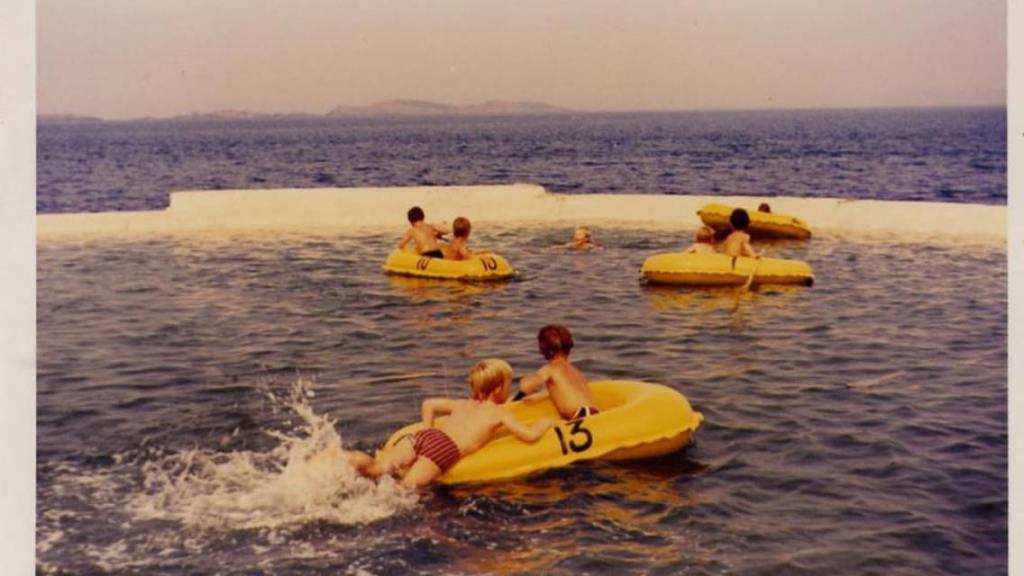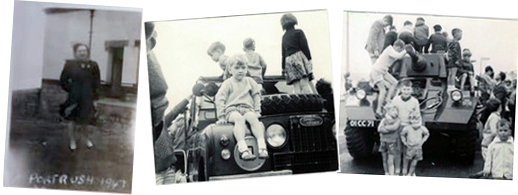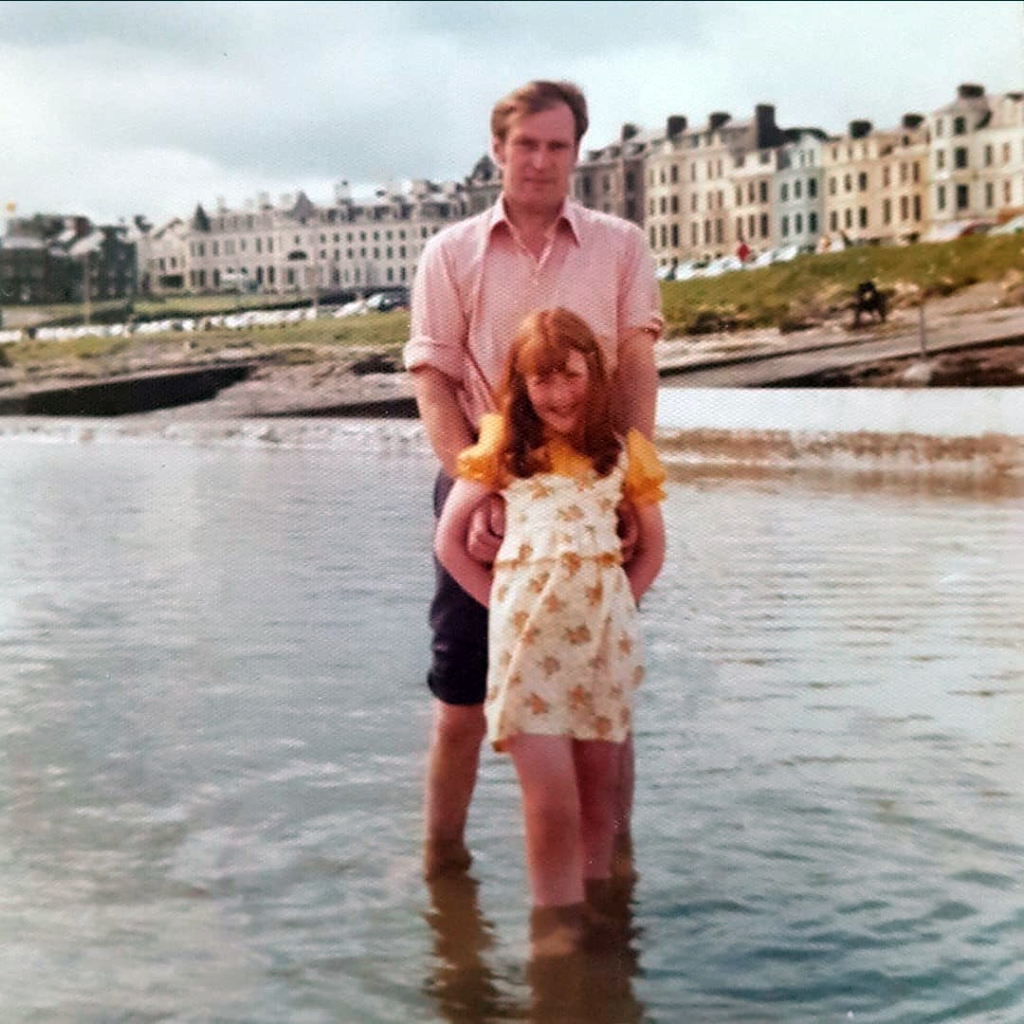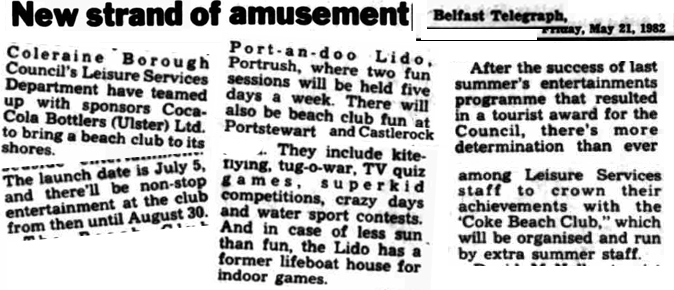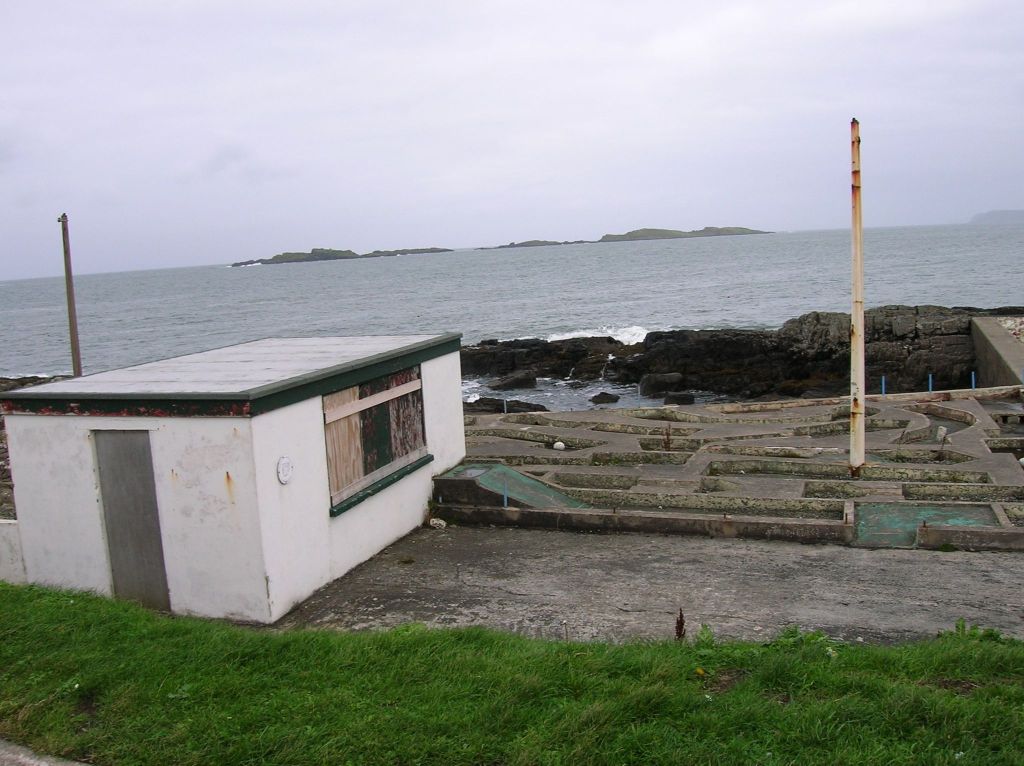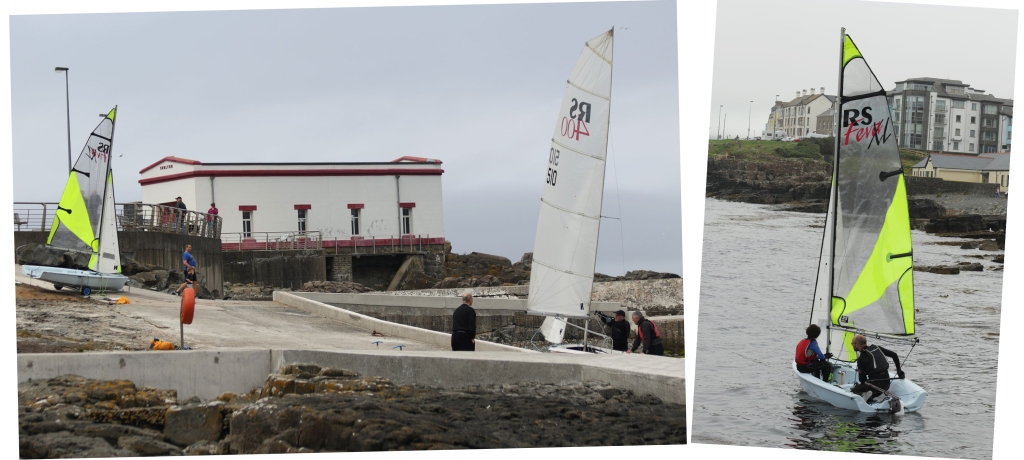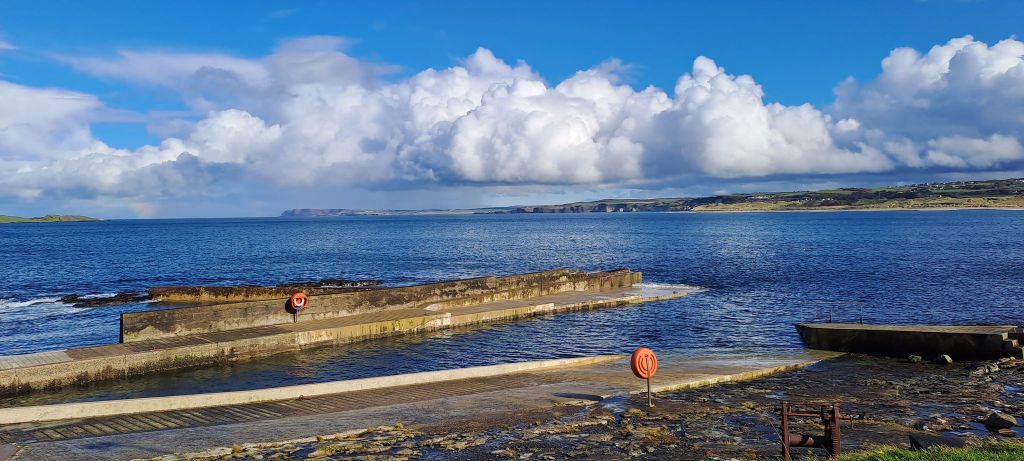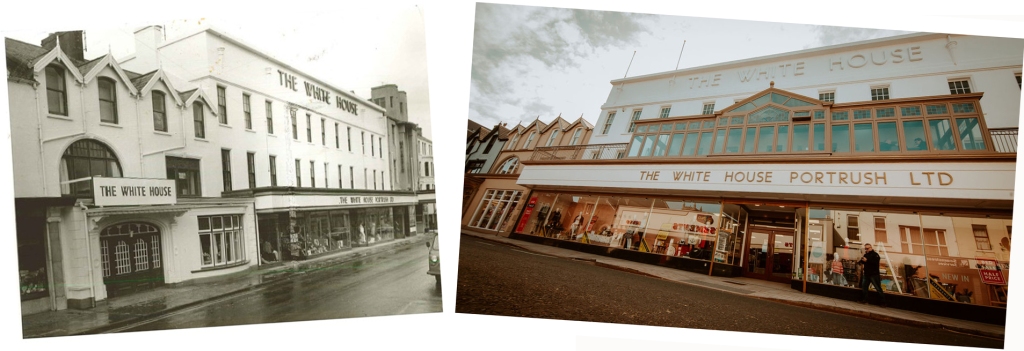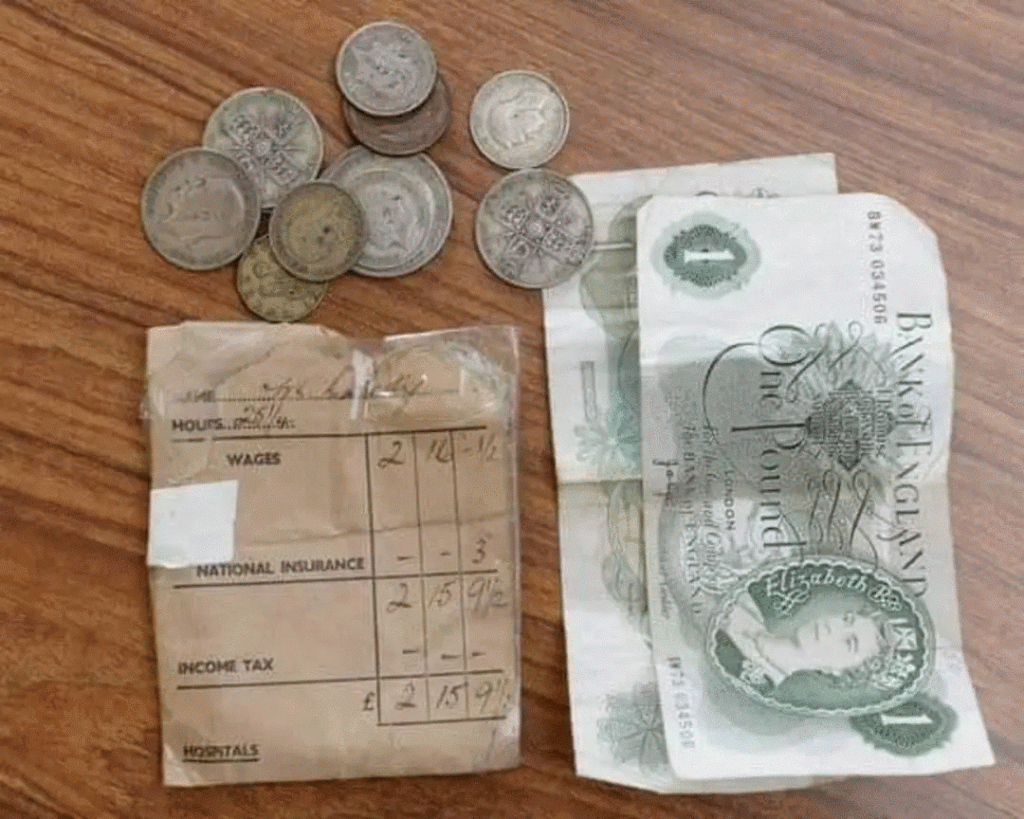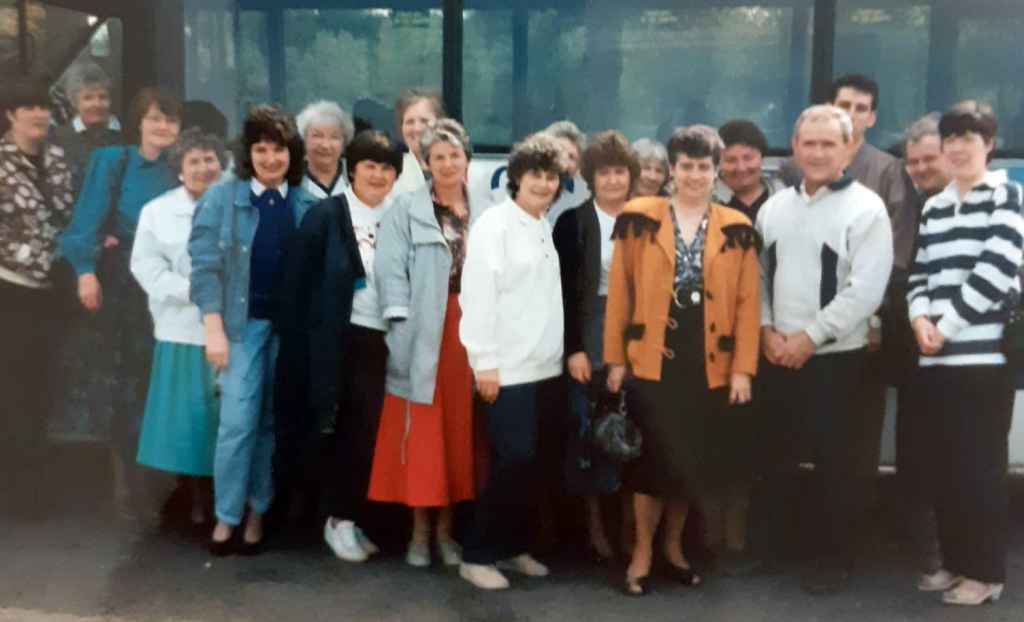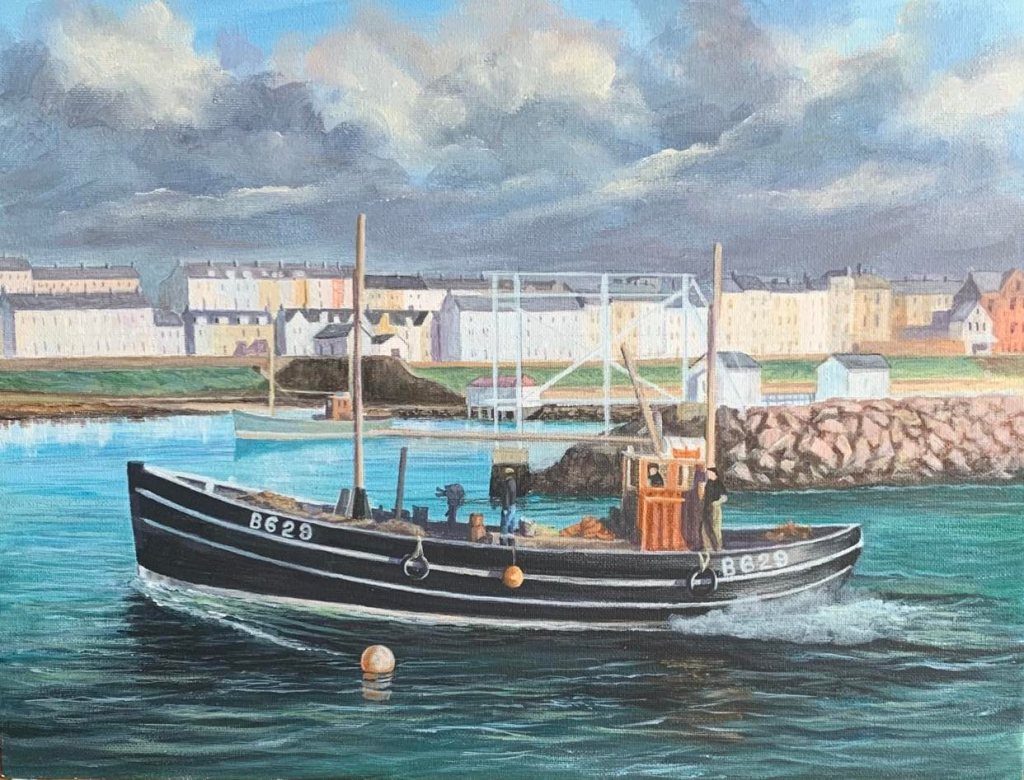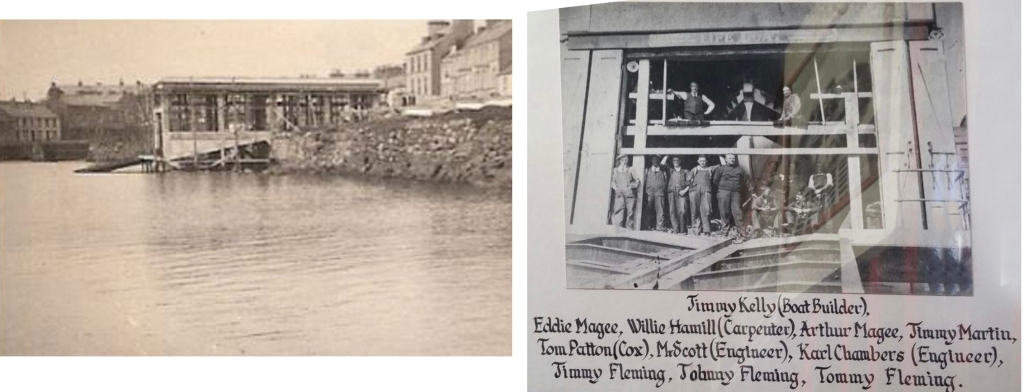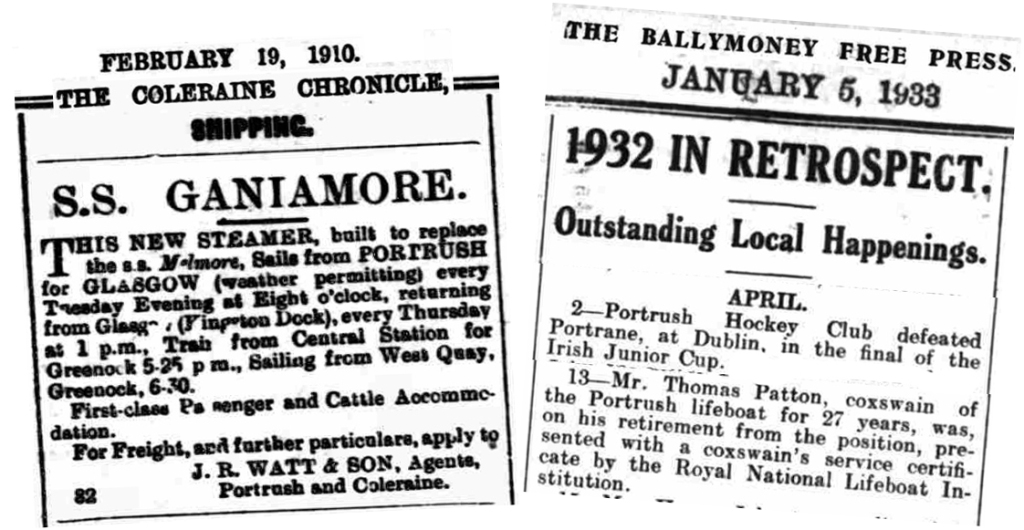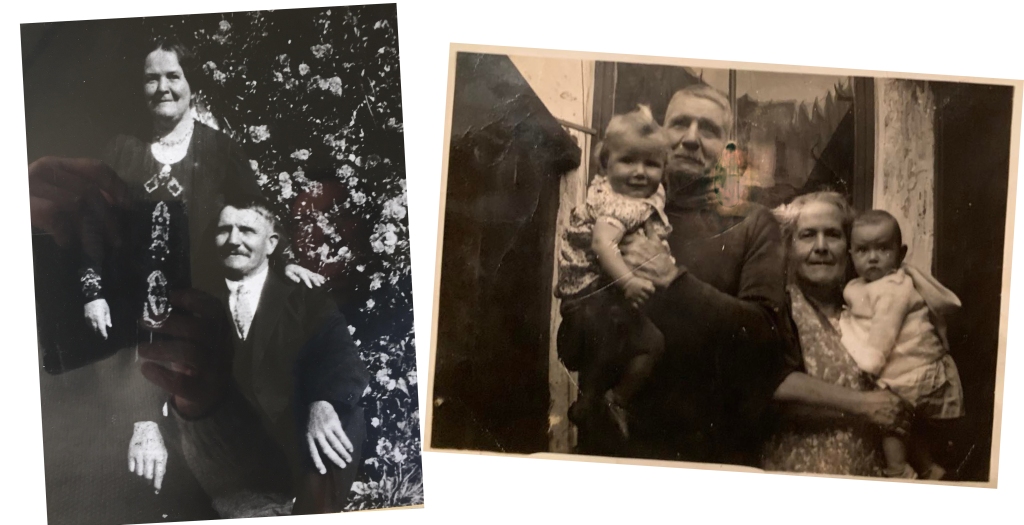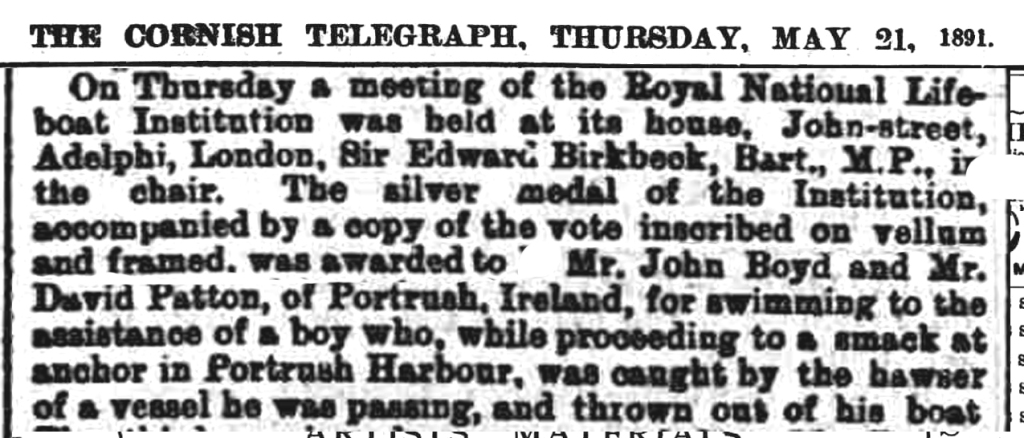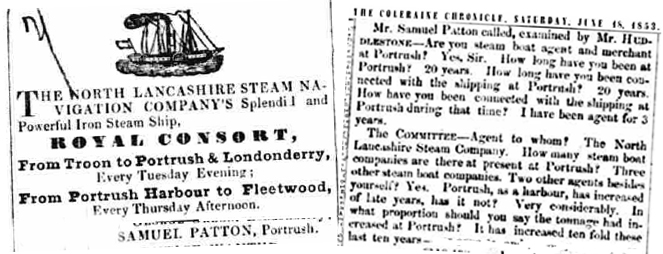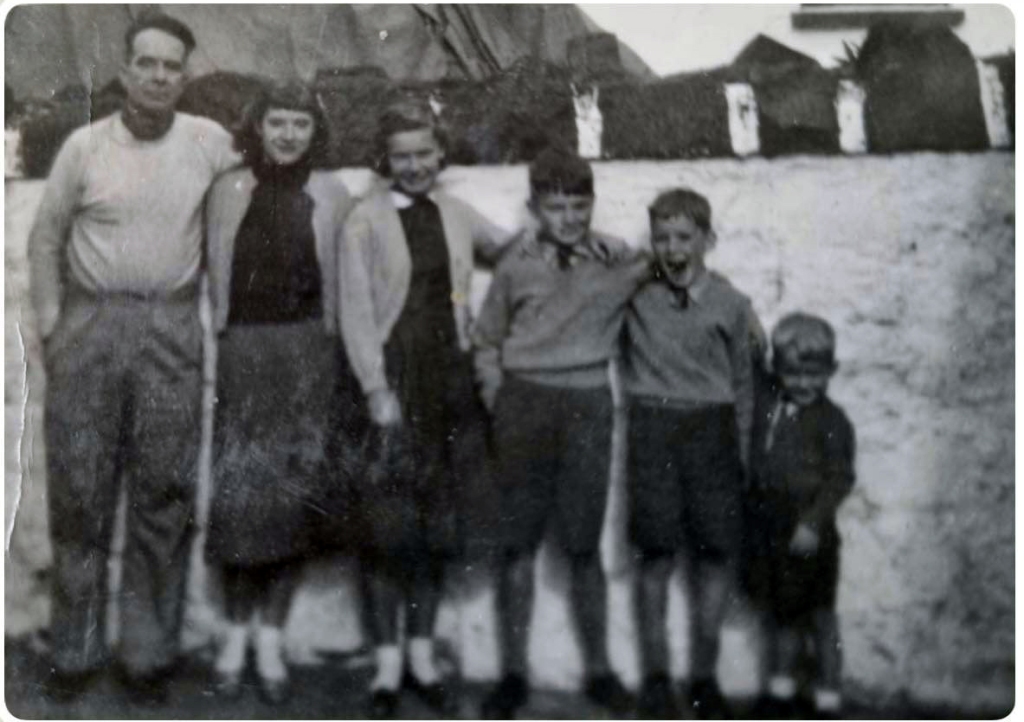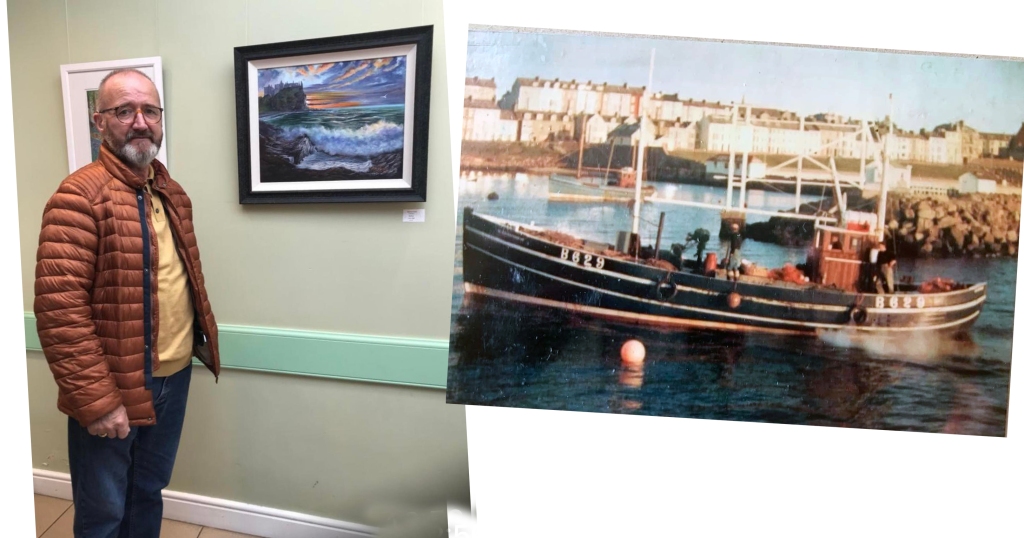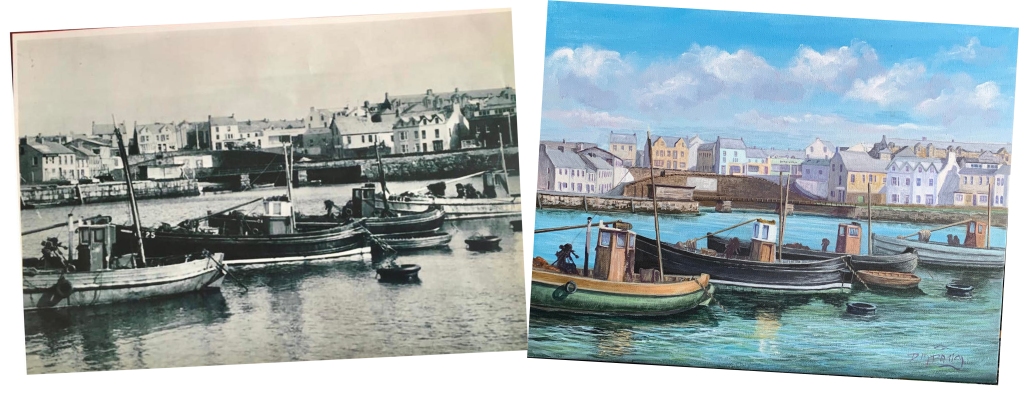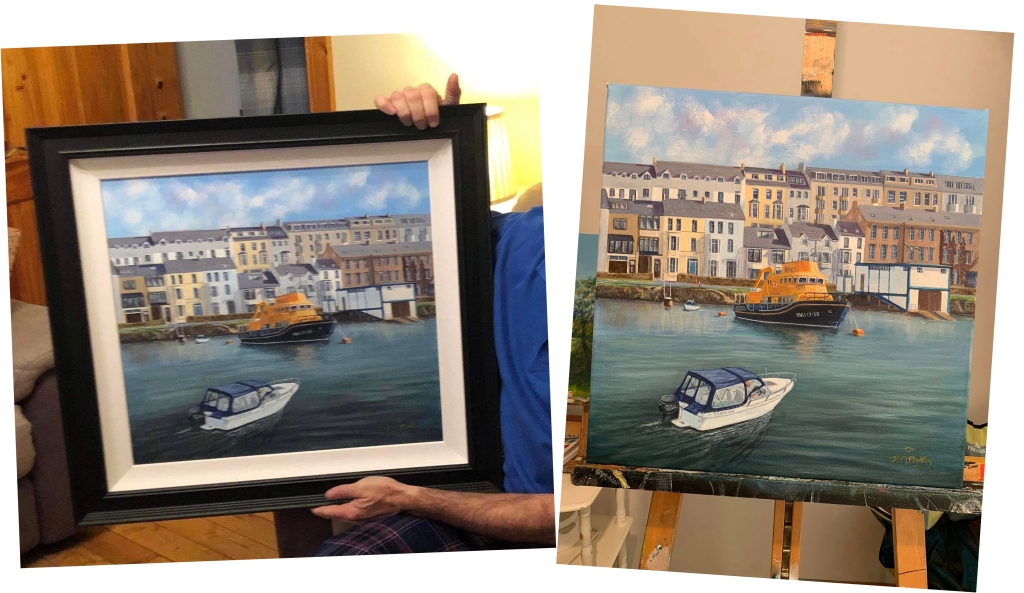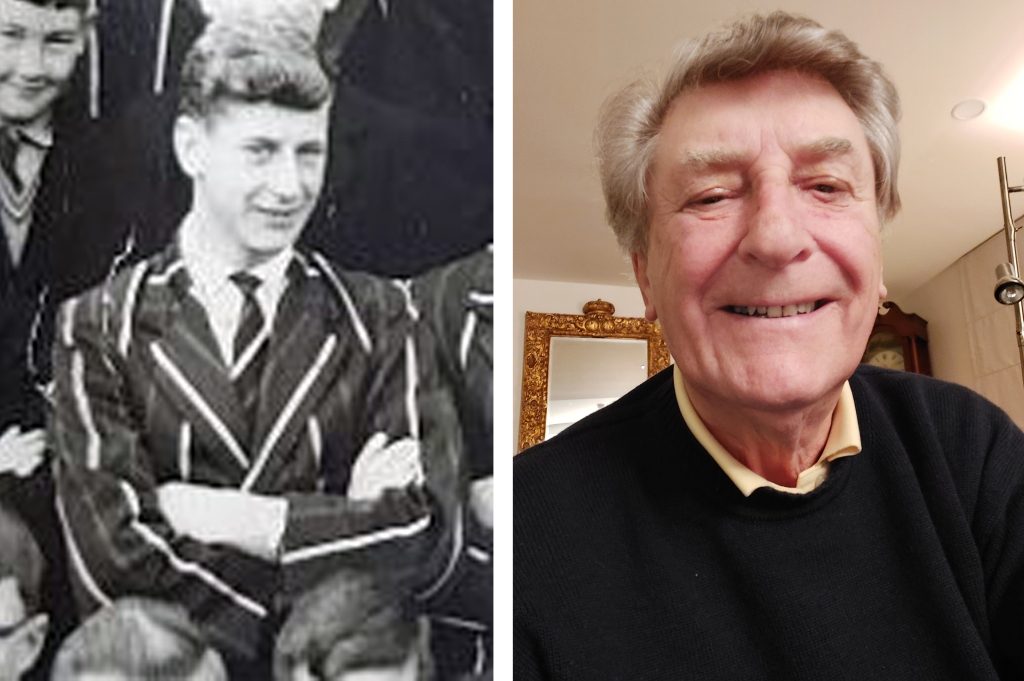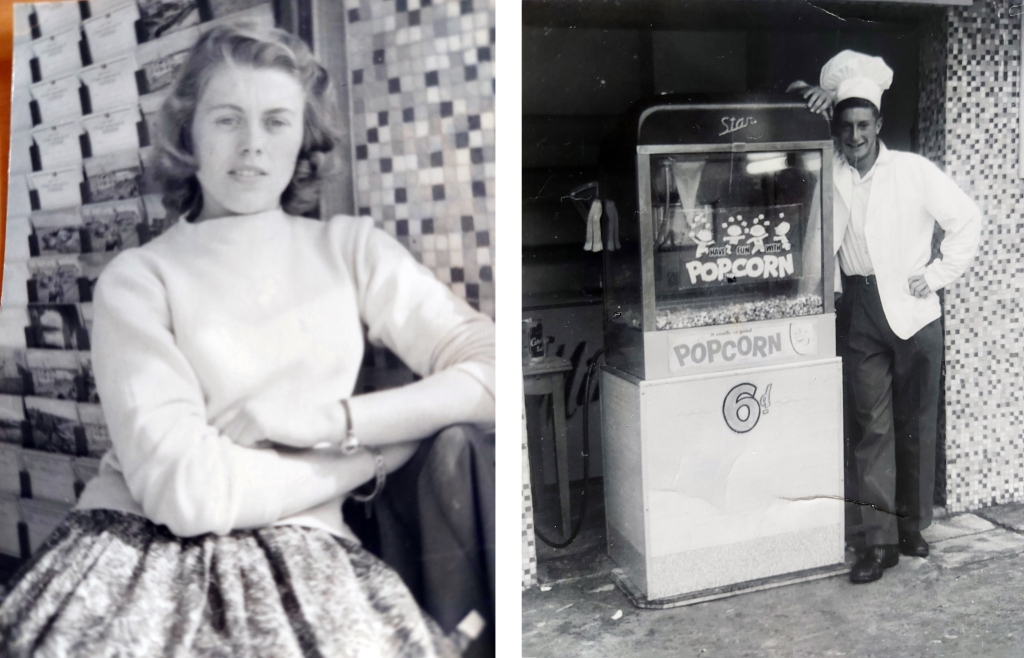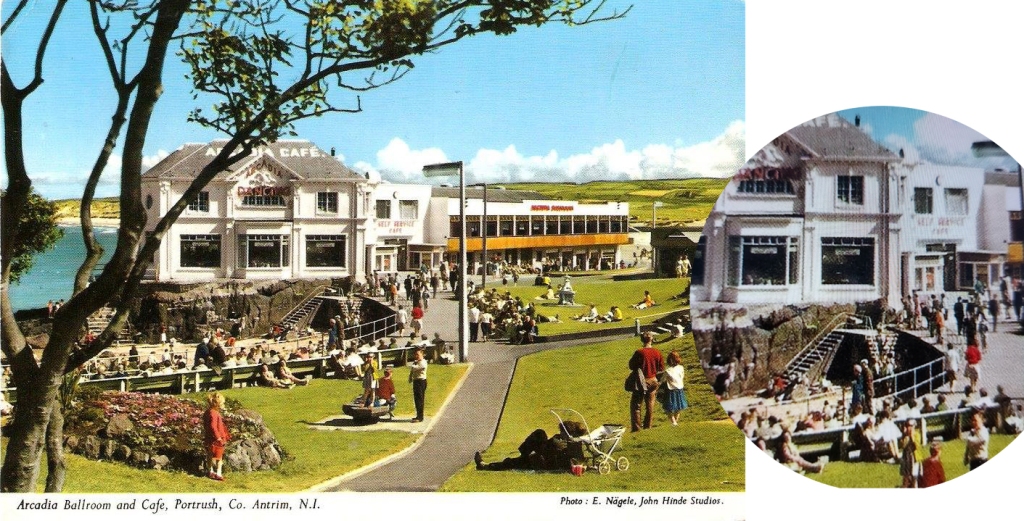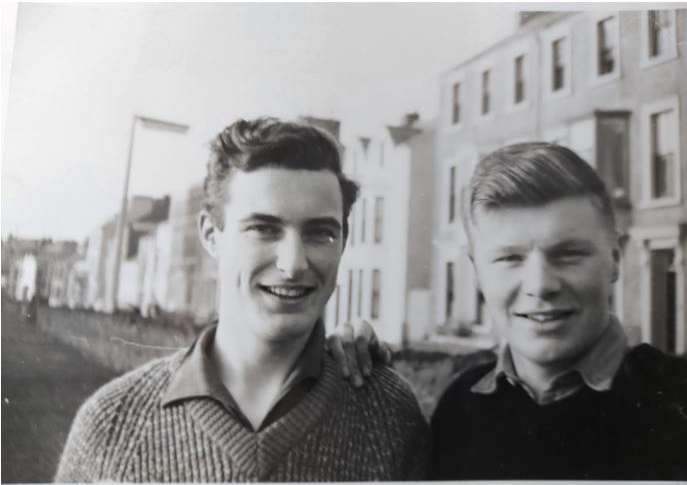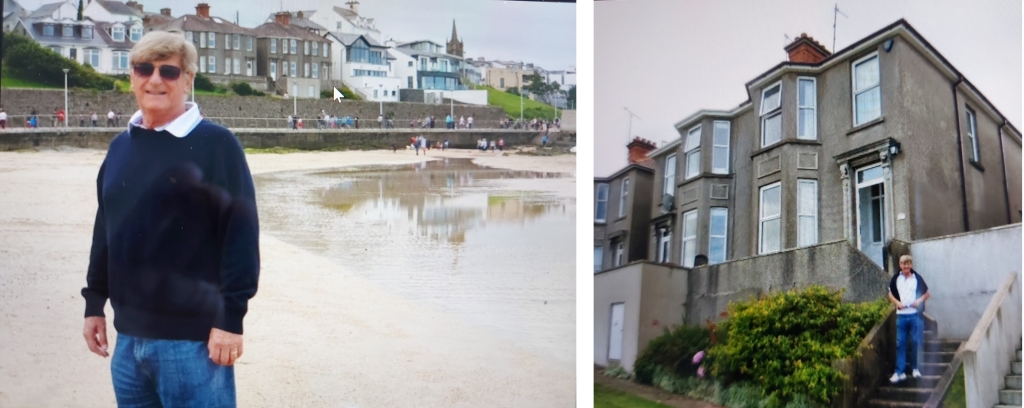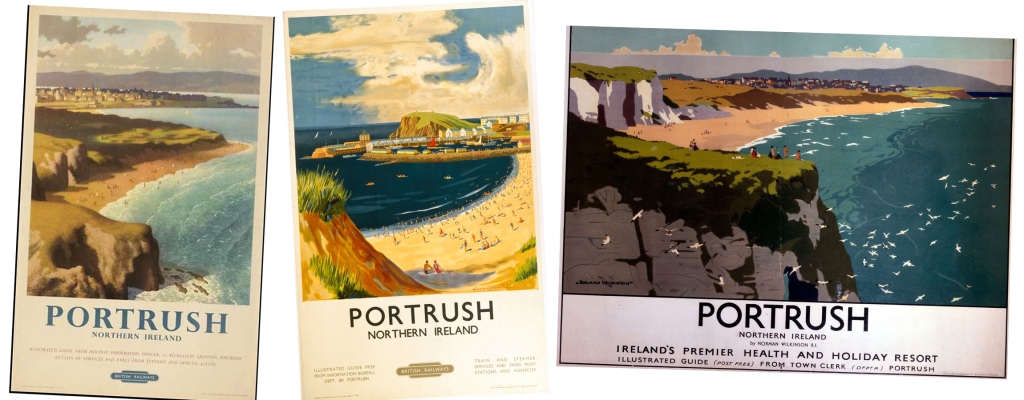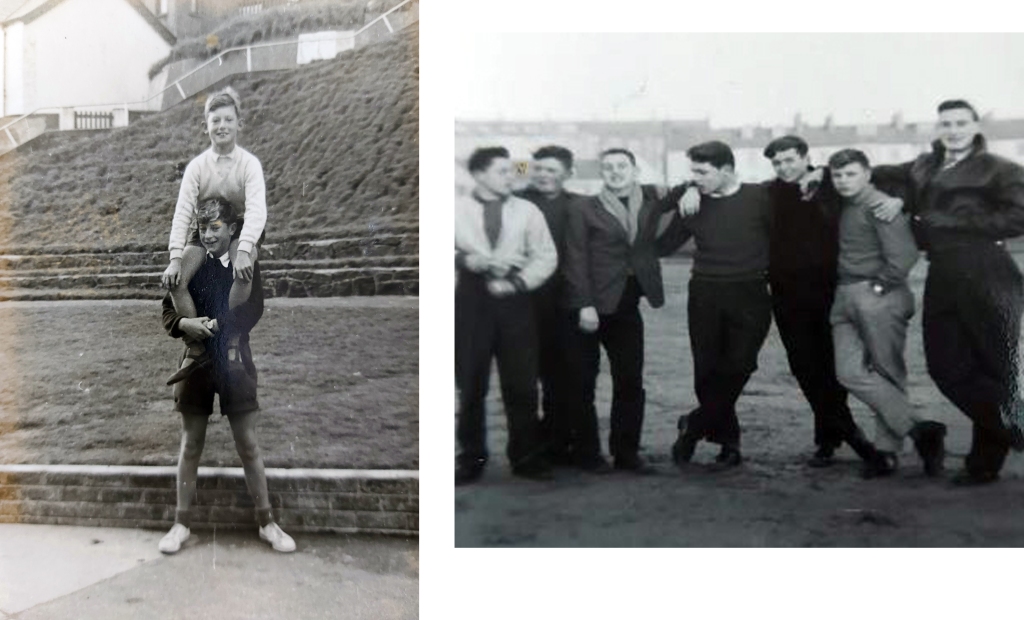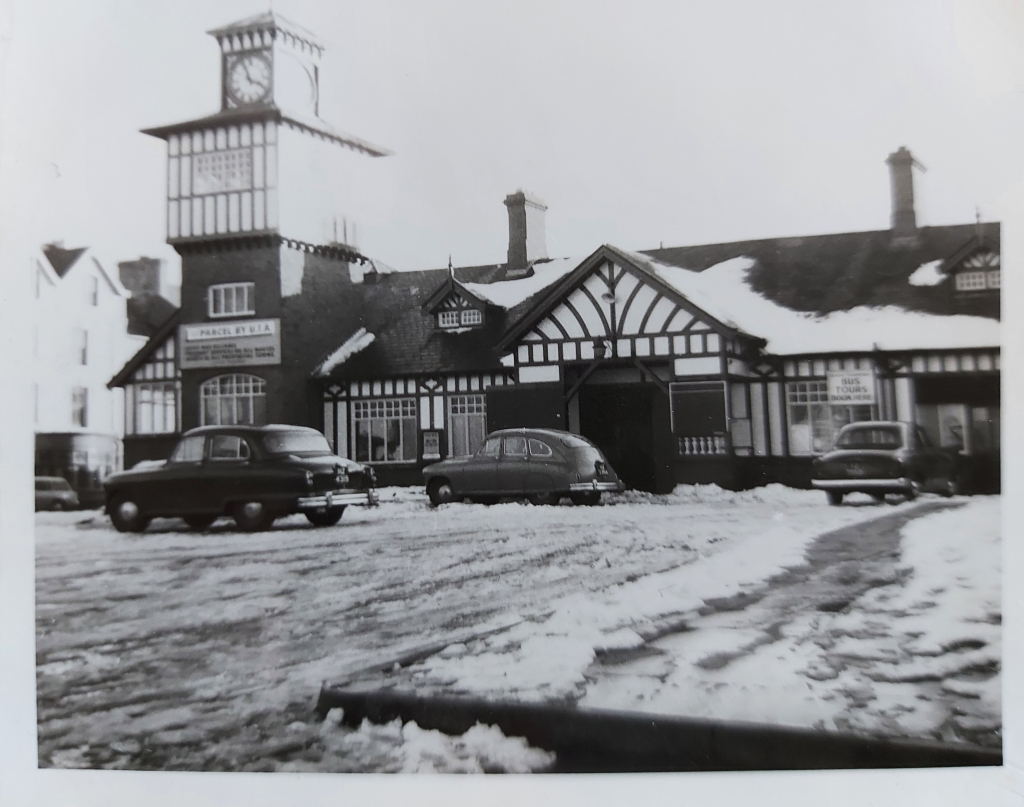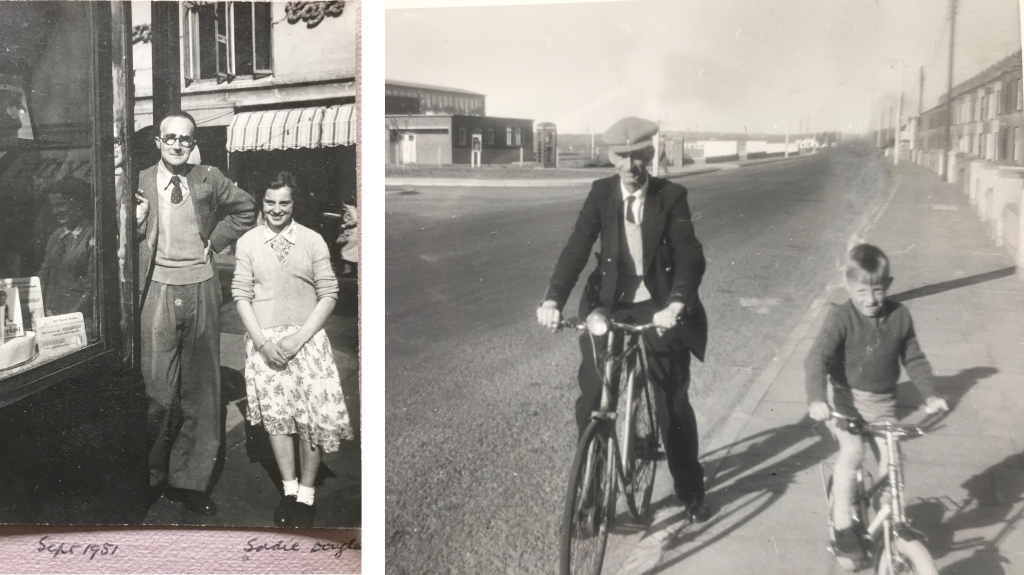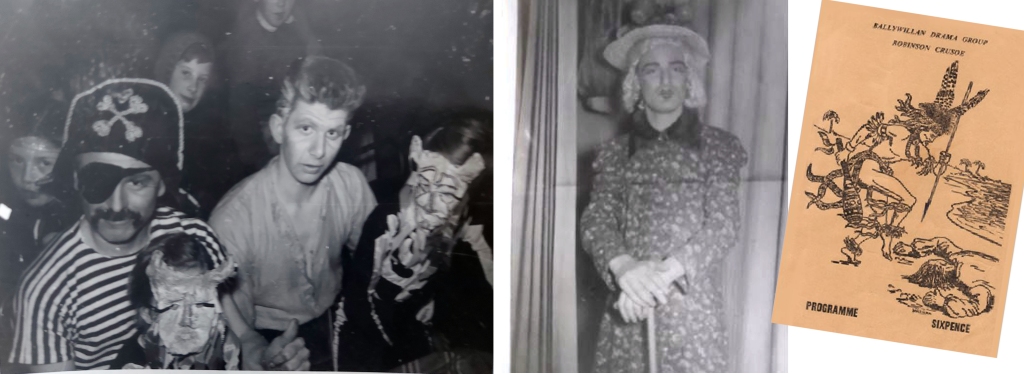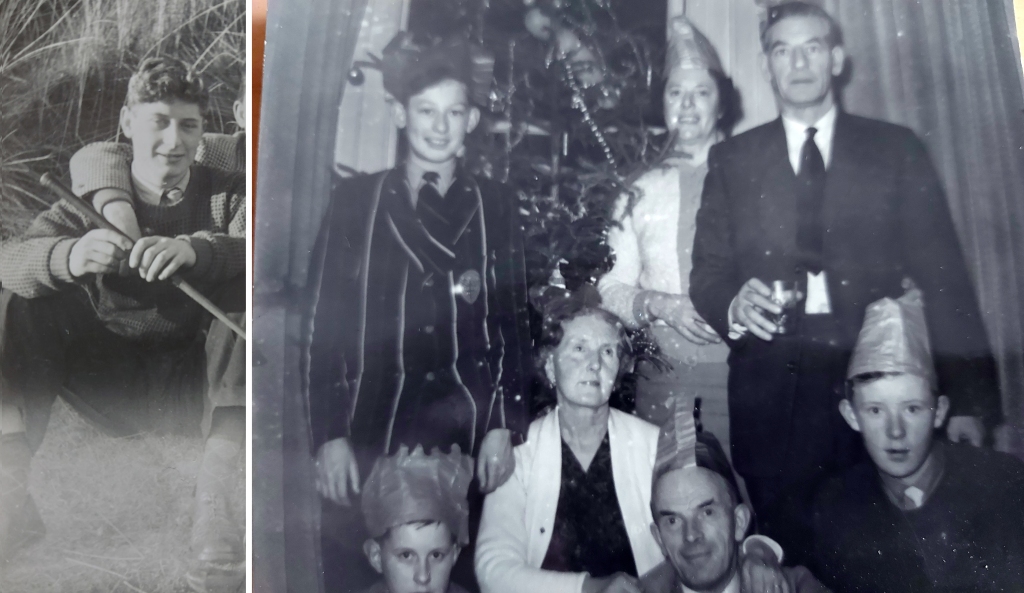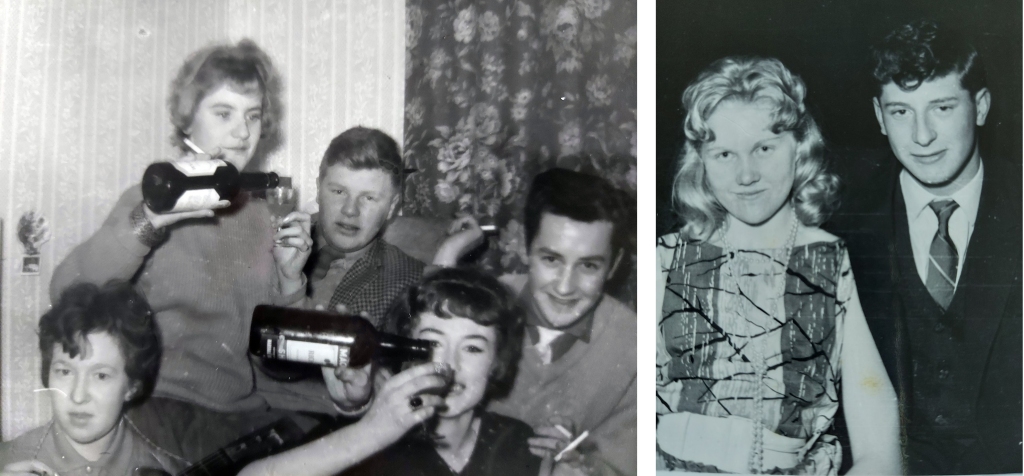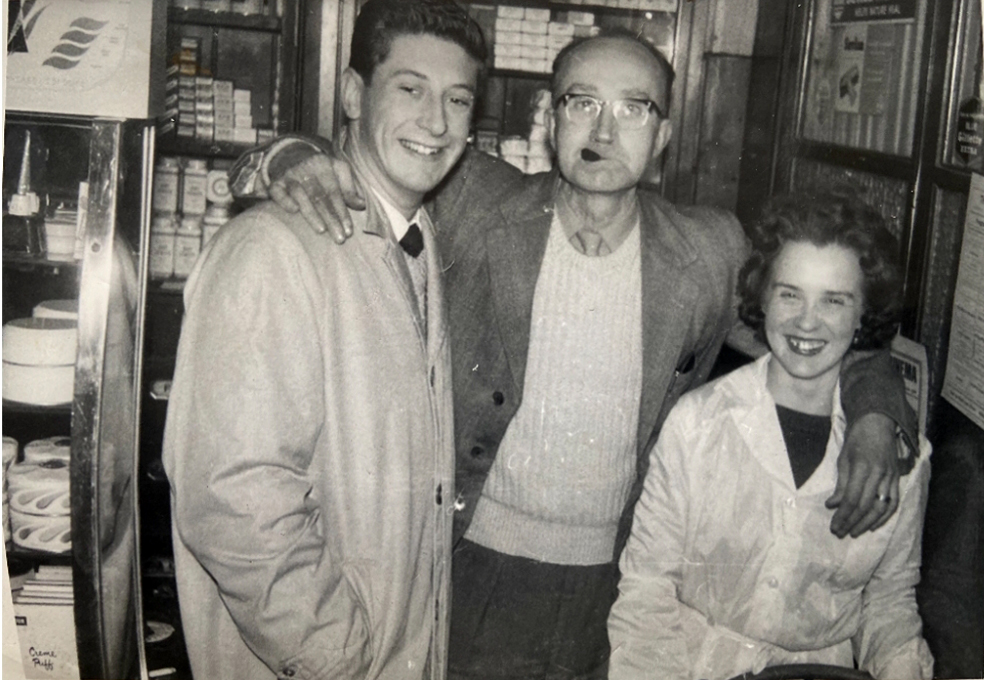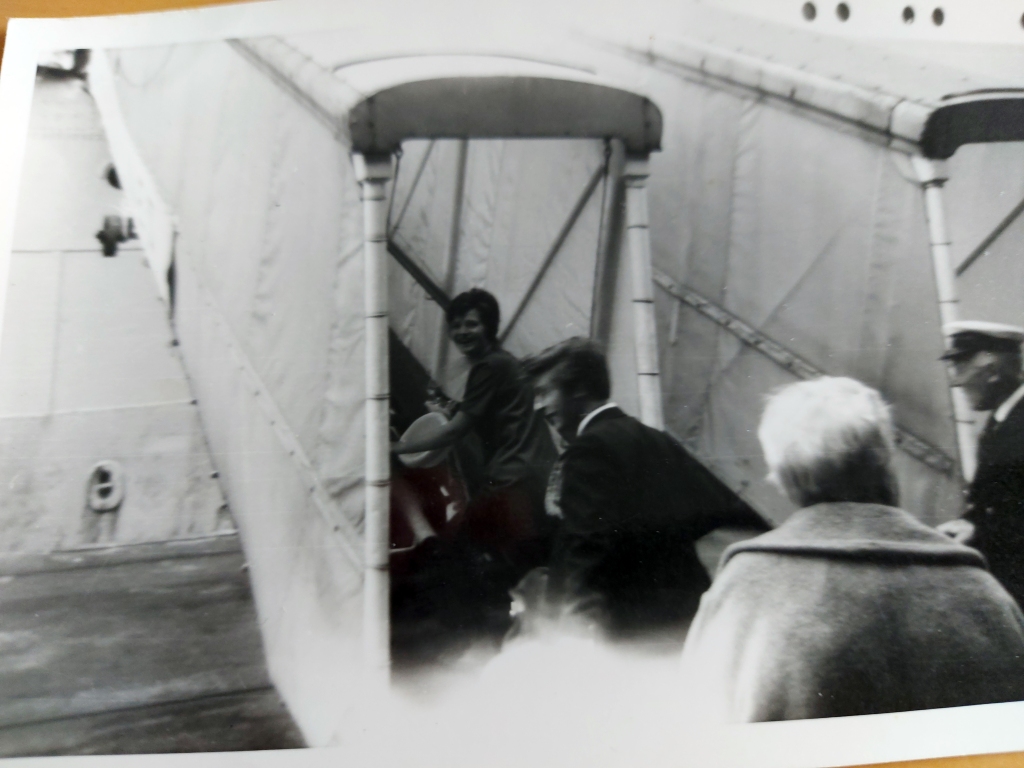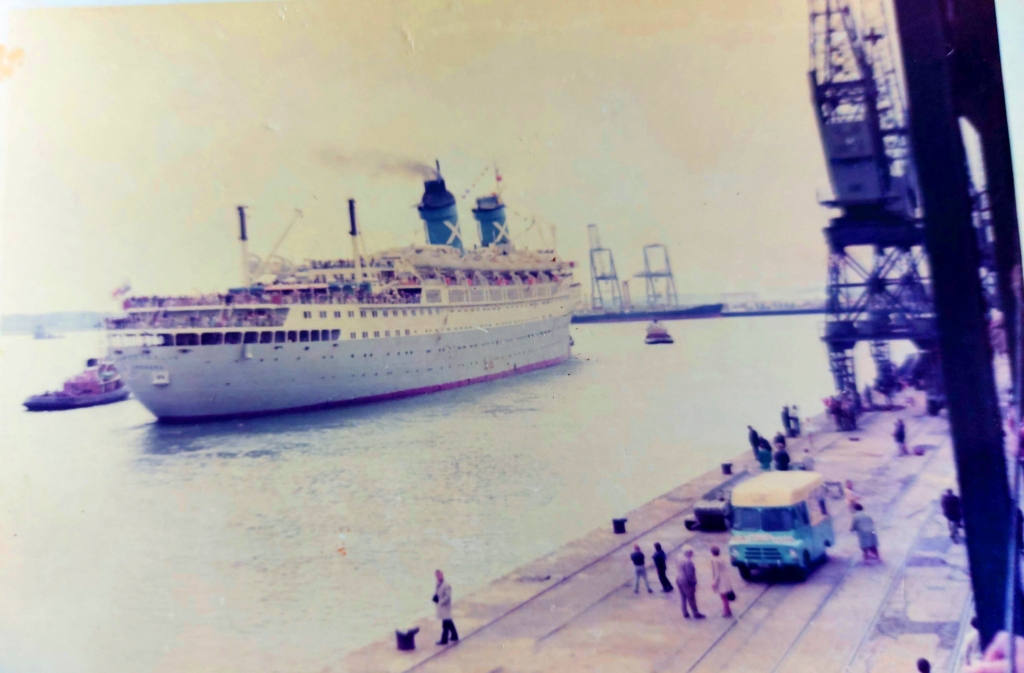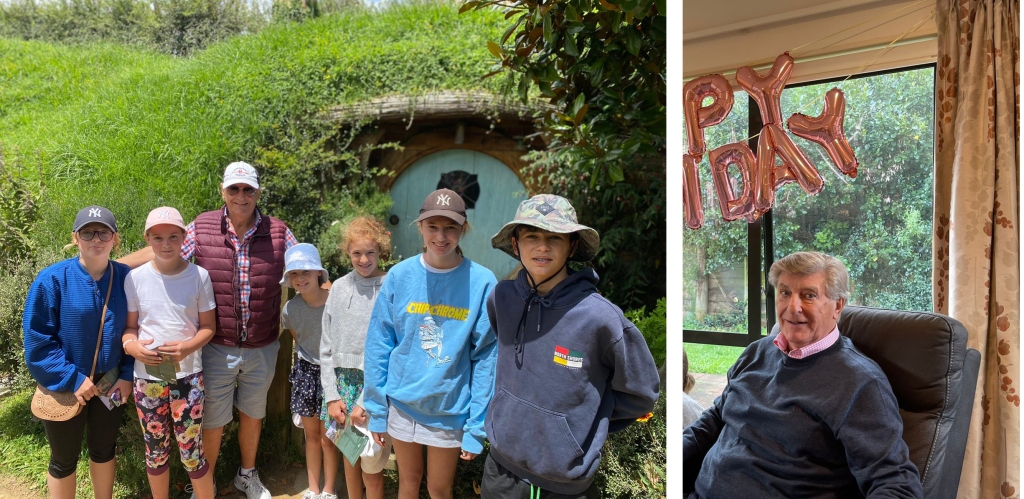15th September 2023: now, milestone of 100,000 views, 115 episodes, 62,000 viewers in 95 countries – thank you, and thank you for your contributions to this enjoyable social history story of Portrush people !
Portrush Tales – me & my family’s & your stories ; the history of the town and the peninsula, going back to the year dot – Vikings, Normans, Strongbow, Dunluce castle and the two Portrush castles, the O’Cahans, the McQuillans, the MacDonnells ; the ‘Great Institutions’ like the lifeboat, Barry’s, CSSM, the Northern Counties, the Metropole, the Girona, … ; the music scene, from ballrooms to the Kiln-an-oge to the Arcadia ; growing up, & school days at Portrush and Dunluce ; golf, badminton, tennis ; cinemas and Portrush Panto ; Jimmy Molloy and the Harbour Bar; ……. Enjoy!

New!
Three sweet shops:
(1) Ross, the Rock Shop
(2) LV Ross, Lower Main St.
(3) Stockmans, the Seaside Supply Store The summer of ’79 / Best years of our lives
(I) Benvarden: into the Lion’s den
(II) Causeway Coast Safari Park
Portrush, Ramore Head – Siganl Station, WWII
from Croc-na-mac neighbours, the Edgars:
Postcards from Portrush: Donkeys on the East Strand
Postcards from Portrush: Donkeys (II) on the *West* Strand
Sgt. Fulton – last of RIC, first and last of RUC
Empire builders, Organ grinders, Spanish ladies – it’s Portrush Carnival!
Postcards from Portrush: Landsdowne, the ‘Counties, & The White House
Portrush fishing fleet
@ Portandhu –
(I) ‘No Man’s Land’ at Portandhu – – early years
(II) ‘Nobody’s Child’ at Portandhu – bringing it up to date
@ the harbour –
(3): “Fifty trawlers a week” at Portrush Harbour
(4) “Portrush as new fishing port: History is repeating”
(5) Portrush: HQ for Fishing fleet? Good times, bad times
(6) The Portrush fishing fleet
The Carnalridge sagas:
(I) the Bankhead years – based on Trish Gray stories, 1960s
(II) Bankhead, Revisited – based on Reba Jackson stories, 1950s, and earlier
(III) the McIlgorm years – based on Ian McIlgorm stories
(IV) the Millar Years – David Millar, head 1980 – 2010
The White House Tales, by Gerald McQuilken:
(IV) Socialising, by Gerald
(III) Styling, by Gerald
(II) Skiving, by Gerald
(I) Starting, by Gerald
Blog: “Leadership at The White House“
Development of Croc-na-mac & Rodney Squares, & Hamilton Place
1946 – the Year of the Prefab –
Croc-na-mac: Tin Huts to Steel Pre-fabs to Brick Homes
Portrush Tales: The Two Sheilas – Sheila Kane & Sheila Brown
“Postcards from Portrush” based on the postcard collection from Sheila Brown
(I) The story of Eglinton St.
(II) the West Strand & Harbour
(III) Harbour Tales
(IV) the Recreation Grounds, renewed
(v) Landsdowne, the ‘Counties, & The White House
(VI) Diving at the Blue Pool
(VII) Portraits of Portrush: Patton of the harbour
(viii) Donkeys on the East Strand & the Causeway
(ix) McNaughten & the Causeway

4th July 2023 ( 2 1/2 years): 106 posts, over 91,000 views, 56,000 visitors, 88 countries 🙂
21 Dec 22 (2 years): 84 posts, 71,000 views, 44,000 visitors, in 75 countries !!
25 May22 (1 1/2 years) 53,000 views, 32,500 visitors
04 Dec 21 (1 year): 40,000 views, 62 posts
Cyril Davison – a Tribute
Her Majesty the Queen – Silver Jubilee visit, 1977
The Strand Ballroom in Portstewart:
– Part I – the Ballroom of Romance
– Part II – from Helen Shapiro to Engelbert Humperdinck to Eric Clapton
“Portrush Tales” from Michael White now living in New Zealand – great set of Inst friends, teenagers in Portrush around 1960 – great fun and friendships!
– Part I – from The Other Side of the World – Michael White
– Part II – to The Farthest Shore – Michael White

‘Portrush Tales‘ read mostly in UK of course, but almost 99 other countries – United States, Ireland, Canada, Australia, Germany, New Zealand, Spain, France, Netherlands, Italy, South Africa, Sweden, Portugal, Belgium, Denmark, Austria, Greece, Jersey, Turkey, United Arab Emirates, Mexico, Poland, Singapore, Switzerland, Cyprus, Qatar, Norway, Guernsey, Tunisia, Isle of Man, Hong Kong SAR China, Kuwait, Finland, Thailand, Malaysia,Bulgaria, India, Philippines, Czechia, Slovenia, Indonesia, Ecuador, Cambodia, Vietnam, South Korea, Luxembourg, Saudi Arabia, Egypt, Japan, Zambia, Nigeria, Puerto Rico, Sri Lanka, Romania, Uganda, Dominican Republic, American Samoa, Taiwan, Gibraltar, Somalia, European Union, Brazil, Moldova, Côte d’Ivoire, Colombia, Croatia, Argentina, St. Lucia, Hungary, Maldives, Kenya, Malta, French Polynesia, Ukraine, Algeria, Cayman Islands, Bahrain, Mauritius, Fiji, Angola, Barbados, British Virgin Islands, Seychelles, Panama, Israel, Cook Islands, Serbia, Albania, Andorra, Lithuania, Saint Maarten, Iceland, ……
100 years of Badminton at the Kelly Hall
Our Mum: Maud Martin 1926-2022
Rollerskating at Portrush – into the Guinness Book of Records
Dana / The Brown Sisters series:
(I) Dana -Coming to Portrush
– Dana (Rosemary Brown) arrives to the delights of Portrush
(II) Dana – Summer job at Minihan’s, Portrush
– as young teenager, Dana works at Minihan’s shop, signs at Fawcett’s & then the Palladium
(III) The Brown Sisters at the Portrush Palladium !!
– 1964, summer season in the Edwin Heath show – her break into the big time!
(IV): from Portrush Palladium to Eurovision and beyond
– after the Palladium season: school, Eurovision – but with continuing connection with Portrush
Podcasts – Dana / Rosemary & Susan Brown
Dana – Part 1 – Coming to Portrush
Dana – Part II – Summer jobs at Minihan’s
Dana – Part III – the Brown family
Susan – Part I – from the Palladium to Decca Records and 5-year contract
Susan – Part II – Fun at Portrush
Susan – Part III – Music & The Big Nights in Derry
(IIa) Ramore St. development, 1960s
– from Ramore St, Garden Ct, Quarry Ct, ….. to the maisonettes
(IIIa) Portrush Ballrooms: the Palladium & Arcadia
– you know the Arcadia, but do you know the Palladium?
Leander House – “The Leander Girls”
– that house that was next to the Blue Pool – so rich in Portrush history
The Metropole – Ministry of Finance – Portrush’s biggest employer
– the most-read blog!
Portrush cinema (III) the forgotten Film Festival
– 1994, with Stephen Frears – but oh no-one went to it, no-one remembers it!
Portrush floods – August 1960
– the big floods around Dhu Varren
The photographer of Portrush (3) Destruction, 1976
– that dreadful night in Portrush, August 1976
Great institutions
Jimmy Molloy and the Harbour Bar
Portrush – the Harbour – amazing history of the harbour
Gregg’s dinghy pool, Portandhu lido – and my summer work with the Council
Leadership at The White House
The Night the ‘Counties Died – the Northern Counties – on the site of the ancient abbey
The Metropole Hotel – Decline and Fall
Landmarks of Portrush: Castle Erin
‘Teas and Ices’ cafe and the Great Train Robbery
Hamilton Place and the Charge of the Light Brigade – rather surprising discovery, with great history of the place!
the Recreation grounds – 100 years
Portrush CSSM – Summer is here!
Kelly Hall: Badminton, Burning, Bullets, Bayonets
“The Croc-na-mac boulevard!” – the development of the best street in town 🙂

My Dad: Sergeant Martin – ten years after his passing, in 2010
My Mum: Maud Martin (in Madelayne Court in Portstewart, celebrated her 95th in October)
The Photographer of Portrush
(1) L’Atelier studio – the studio on Main St, described by Trish Gray (nee Patricia Lee)
(2) Lee family album, 100 years – 1880s to 1980s, story richly illustrated with your photographs
(3) Destruction, 1976 – that dreadful night in Portrush, August 1976
School days
I. Portrush schools – growing pains – the development of schools in Portrush
II. Portrush Primary School – Infants, downstairs
III. Portrush Primary School – Seniors, upstairs
IV. Portrush Primary School and the West Germany football team
V. Portrush Primary School – P7 and the School Trip
PODCASTs (in a silly voice though): Episode 1, Episode II, Episode III
Sunday School Excursion to Portrush – coming to Portrush, excursion in 1950s
On the bus to Dunluce School – school days, teachers, activities, badminton successes, sports, ….
Dunluce School plays Billy Liar, 1980 – hilarious stories from Sheila K in Sixth Form !

The 1960s & 70s
the Belfast Telegraph: Portrush and the sizzling ’70s – news through the decade
Portrush floods – August 1960 – the big floods around Dhu Varren
Portrush, 1960s – the Swinging Sixties! – news through the decade
Portrush, 1960s – On the beach! – my toddler years, bliss!
That’s entertainment – Music, Cinema, Theatre, Barry’s
Portrush music: Showbands to Stranglers, ’60s and ’70s – Kelly’s, the Arcadia, Kiln-an-oge, ……
Barry’s –
Portrush, Easter – My Day in Barry’s
“It is the cacophony of noise and the flashing of neon lights and the smells of sickly popcorn and of grease that hits you when you walk in the front door of Barry’s. And the electric sparking of the Speedway. And the excitement. It is Easter Saturday, the opening day of the season…”
Barry’s and the Wall of Death
Barry’s and the Helter Skelter
Portrush cinema –
(I) 125 years – Pavilion, Palace, Picture, Playhouse – the story of cinemas in Portrush
(II) The Playhouse, year 2000 – awesome write-up of the years working at the cinema and cinema-going
(III) the forgotten Film Festival – 1994, with Stephen Frears – but oh noone remembers it!
Portrush Town Hall, theatre, pantomime, musicals, Waterworld –
Act I: Dramas at the Town Hall, 1870 to 1970 – Town Hall, start and first 100 years
Act II: Portrush Panto, 1970s and ’80s – the next 25 years until the demise of the Town Hall
Act III: Pantos – Waterworld 1990s, and at Town Hall 2010s
Act IV: Waterworld – The Musicals – late 1990s
(Act V – Performances at the Riverside – well the gap is there, but you will have to write it !)
Causeway Coast
“You must see the Giant’s Causeway” – Portrush development was strongly based on the GC
The Causeway Tram: “It was only a tram”
The Girona: Robert Stenuit in “The Dive” – finding the Spanish Armada galleas, Girona
Dhu Varren – The town between the ports
Coast path – Tides, Typhoid and Tornado – the walk to Morelli’s and through the stories of the coast path
West Strand and the Boxing Day curse – family stories and mishaps….
Mishaps on the East Strand – family stories and mishaps….
Golf
the Sandhills and the Triangle – the start of Portrush golf
1100s: Did the Vikings play golf? with The Open, 2019
The development of Portrush
1850s – The Steam Train Cometh – & the railway station, quarrying, train line and bridge to the harbour
Portrush – Living on an Island – wow so interesting look at the geography of Portrush!
PODCAST – Living on an island
The 1800s: of Trains, Tram and Tourists – boom times for Portrush and the Empire
The 1700s: of Trials, Tears, and Transport – Portrush impoverished, & big migrations
1600s – a Century of Trouble – the plantation of Ulster, Bushmills whiskey, MacDonnells & Dunluce wealth, civil war, destruction of Portrush castles, the Girona wreck
1100 – 1600: the Normans are here! – Norman invaders, Strongbow cider, Dunluce castle, Portrush abbey
1100s: Did the Vikings play golf ? – the Viking era, & war hollow, & the Open Golf, 2019 !

Mayday! Mayday! Portrush lifeboat
(1) Prepare to launch – 1840s and leading up to the start of Portrush lifeboat; and films of launch, 1960s
(2) Tragedy and Awards, 1889-91 – fatal lifeboat call-out, rewards for quiet herosim
(3) Saving lives, 1900-1980 – rescues and heroism
(4) from A to B: Argo to Bergen – the BIG call-outs, 1960 & 1965
(5)“What’s It All About?” – other news, buildings, training, developments, rescues
Lifeboat: the Bergen Incident – the 1965 incident, recounted by Fred Williams
PODCAST (listen): The recording of Robert McMullan’s voice, of his view of the Bergen incident, is here.
With best wishes,
David Martin November 2022
================






























